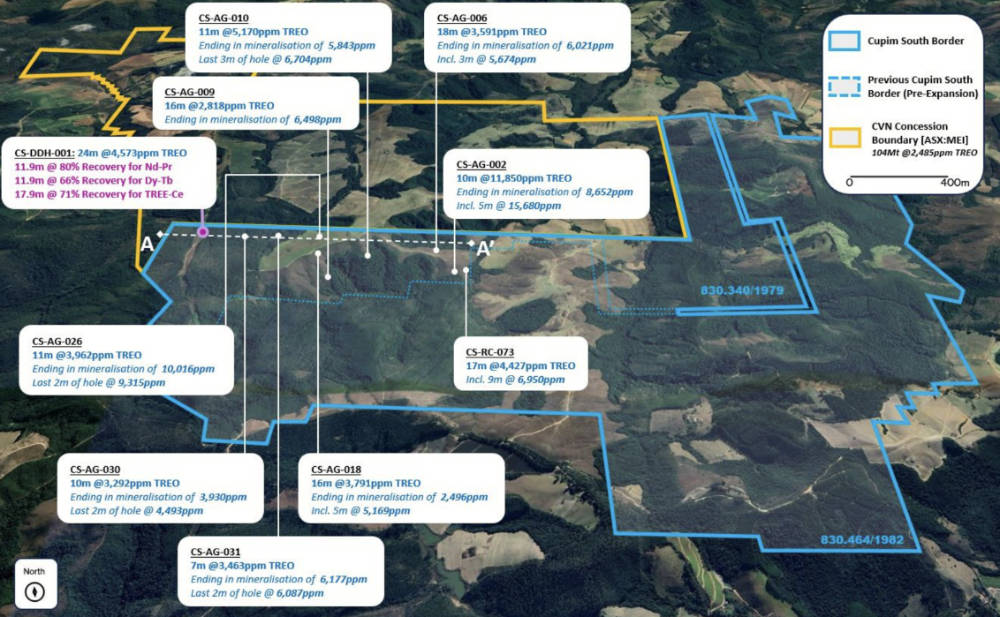Ionic adsorption clay REE? ANSTO confirms what Viridis always suspected about the Colossus project
Mining
Mining
Special Report: Initial test work carried out by ANSTO on samples from Viridis Mining & Minerals’ first diamond hole has returned an average 80% recovery of valuable NdPr, confirming that Colossus is indeed an ionic adsorption clay-hosted REE project.
Ionic adsorption clay (IAC) rare earth projects are very highly sought due to their potential to deliver low-cost, high-margin operations despite their relatively low grades.
Operations are characterised by simple mining and processing methodology, non-radioactive products and waste, as well as attractive mineralogy and saleable product composition, which is weighted towards the valuable magnet REEs such as neodymium-praseodymium (NdPr) and dysprosium-terbium (DyTb).
Viridis Mining & Minerals (ASX:VMM) acquired the 91km2 Colossus project in August 2023 and has since expanded its landholding within Poços de Caldas, Brazil, up to a dominant 239km2.
This includes a recent acquisition that expands the Cupim South prospect into a 15.75km2 corridor between the 92Mt Sobero deposit where holes such as 21.4m @ 4,896ppm TREO were reported, and the 104Mt Cupim Vermelho Norte deposit where historical auger drilling by JOGMEC intersected 16m @ 3,100ppm TREO about 180m away.
Maiden drilling by the company delivered encouraging thickness and grades such as 46m @ 3,285ppm total rare earth oxides (27% magnet rare earth oxides) and 24m @ 4,573ppm TREO (38% MREO).
More recently, step-out drilling uncovered the highest grade zone of up to 24,894ppm TREO within a broader 10m @ 11,850ppm TREO (43% MREO) intersection in the recently acquired southern complex expansions, while diamond drilling uncovered the best grades to date at the Caminho Das Pedras mining licence of 21m @ 5,210ppm TREO (31% MREO).

Drill holes at Cupim South. Pic: Supplied (VMM)
Testing by Australian Nuclear Science and Technology Organisation (ANSTO) on samples taken from the first diamond hole at Cupim South (CS-DDH-001) using a standard ammonium-sulphate at pH4 , room temperature and 30-minute leach cycle returned 80% NdPr and 66% DyTb recoveries across the entire intersection.
Importantly, the test work also returned low levels of impurities in the leached solution.
This provides evidence the expansive and highly-weathered clays at Cupim South are of the much sought after ionic adsorption variety, which will likely drive the company to redouble its efforts.
VMM says this a significant step in validating the world-class nature of the Colossus and has served to de-risk the complexity of the process design and timeline for environmental approvals.
“This incredible result is a significant milestone which confirms that Colossus indeed has the potential to be a world class ionic adsorption clay rare earth resource, with exceptionally high recoveries for both lightand heavy magnet rare earth elements throughout the clay intercept,” VMM chief executive Rafael Moreno said.
“Just as impressive were the low levels of impurities in the leached solution, especially the levels of aluminium which can be difficult to separate in downstream processing operations.
“Although the levels of uranium and thorium in the Colossus feed ore are extremely low to begin with, it’s pleasing to see the metallurgical test work confirm that next to no extraction of uranium and thorium takes place when leaching with pH4 AMSUL solution, supporting a fast-tracked environmental approvals process as per the MoUs recently signed with the State of Minas Gerais and the Municipality of Poços De Caldas.
“The benign leaching conditions, reagent selection and low impurity concentration in the leached solution, simplifies the process flowsheet significantly and strengthens the robust economics of the project, as we look to design and build a low capex production facility, with an opex that puts Colossus at the lowest part of the cost curve.”
The result is the first to be returned from the extensive metallurgical program being undertaken at the project, with more diamond and RC samples already transported to ANSTO for leach testing.
VMM is carrying out more metallurgical drilling across Northern Concessions, Cupim South and Capão Da Onca.
It has also completed three large-scale and extensive bulk samples across Northern Concessions, Cupim South and Capão Da Onca, results from which are expected in late April or early May.
Meanwhile, ANSTO will optimise test work using different leaching conditions to improve recoveries.
This article was developed in collaboration with Viridis Mining & Minerals, a Stockhead advertiser at the time of publishing.
This article does not constitute financial product advice. You should consider obtaining independent advice before making any financial decisions.